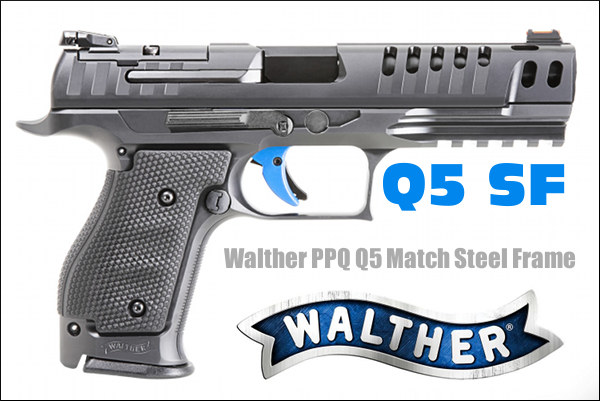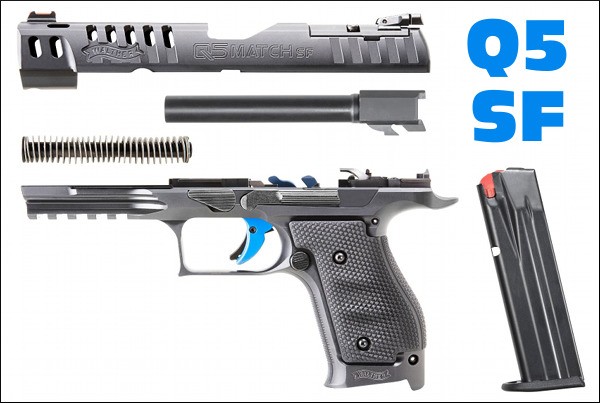New Steel-Frame Walther PPQ Q5 Match SF Pistol
What was old is new again — metal pistol frames. Walther, which has focused on polymer-framed pistols in recent decades, has come out with a metal-framed version of its flagship Q5 model, chambered in 9x19mm (9mm Luger). We like this pistol, official called the Walther PPQ Q5 Match Steel Frame (SF). The metal frame adds mass to the gun, and lowers the center of gravity. That reduces muzzle flip somewhat, as you can see in the comparison video below. Ergonomics are very good, reports early tester Graham Baates, who tested the “optics ready” Q5 SF pistol with red dot sights.
It’s puzzling though — we wonder why Walther didn’t increase the slide weight too, by simply doing away with all the superfluous ports in the slide. That would increase gun weight, reduce muzzle flip (and perceived recoil) even more, and presumably the gun would be cheaper to produce. But maybe Walther thinks the slide cuts are a defining Q5 styling feature that needs to remain, like the Q5’s distinctive Blue Trigger. We guess styling trumps logic…
The Q5 Match SF features an optics ready slide that comes with a Trijicon RMR, Leupold Delta Point, and Docter Optics compatible mounting plate in addition to the standard competition iron sights. Along with a ported slide and the Carl Walther signature ergonomics, and a blue quick defense trigger, the Q5 SF is the flattest shooting model to date.
| TECHNICAL DATA Walther PPQ Q5 Steel Frame Mod. 283001 | |
| All Steel Construction Optics Mounting Plate Extended Frame Rails Ported Slide Model: 2830001 Caliber: 9x19mm Finish: Tenifer Magazines Included: 3 |
Barrel: 5″ long, 1:10″ twist Trigger Pull: 5.6 lbs Capacity: 15 rds (or 17 rds mod. 2830418) Overall Length: 8.7″ Height: 5.4″ Width: 1.3″ Sight Radius: 7.2″ Weight (empty mag): 41.6 oz |
Similar Posts:
- Excellent .22 LR Walther P22 Target Pistol for Just $239.99
- Taurus TX 22 Competition .22 LR Rimfire Pistol
- CANiK METE MC9 PRIME Pistol Earns ICA Carry Gun Honors
- S&W Releases New Metal-Framed M&P9 M2.0 Pistol
- Smith & Wesson Performance Center Ported M&P Pistols
Tags: Pistol Review, PPQ, PPQ Q5 Match, Steel Walther Q5, Walther




















Would the lower fit on my regular ppq slide?
The reason Walther didn’t do away with the slide ports is because you want the slide to stay light so you have less reciprocating mass during recoil. The more mass you have above the bore axis the more muzzle rise/flip you will have. This more muzzle rise/flip the longer the time will be between your splits.
Editor: Loren Pendergrass is a member of Team Walther and a USPSA Master-Class shooter. There is something to what he is saying, but it is not the whole story — if mass reduction truly tamed recoil, then following that logic, why aren’t gun-makers making their slides from carbon fiber? Less is not always more. That said, some race guns DO have ported slides which enable the slides to cycle FASTER for followup shots in the hands of ace shooters. Fundamentally, however, all things being equal, a heavier slide will resist the lifting and twisting forces during recoil. That’s why gunmakers fit bigger, heavier slides for pistols with larger calibers, e.g. .380 ACP vs. .45 ACP.
It’s physics. The energy (from firing the round) which generates both rise and recoil is constant. With more weight in the slide the mass to resist that constant force is greater. Imagine holding one end of a 2′ wood dowel vs. one end of a 2′ steel pipe. Which do you think is harder to angle upwards when holding one end? Back to the real world, we observed the benefit of more muzzle mass firing a Glock 19 with the Brownells G17 Long slide/barrel. Muzzle flip was definitely less with heavier slide. See: https://www.brownells.com/handgun-parts/slide-parts/slides/long-slide-for-gen3-glock-19-nitride-prod115607.aspx. Additionally, the further the weight is forward the more it resists muzzle rise. That is also simple physics. Do this simple test. Get a normal hammer. Hold it horizontal with the metal head in your hand and move the end of the wood handle up. Now reverse the hammer so the metal head is away from your hand. The difference is very dramatic — it takes way more effort to move the hammer head up. This is why slides are made of metal and that metal runs out to the nose of the gun.
Looks like his hand rides higher in the SF, that I like,,,
Mass reduction does not tame recoil. More mass in the correct places help to reduce recoil. If you look at the two leading Production style guns, the CZ Shadow 2 and Tangfolio Witness Elite Stock II, both of these pistols have very narrow slides in regards to height. All the mass to these pistols are below the bore axis or in the frame of the gun. One of the major issues you will have when you increase the slide weight is that when the gun cycles and returns to battery is that the extra weight will cause your muzzle to dip. Or in other words it will cause your front sight to dip below your rear sight. This in turn increases our split times from shot to shot.
I shot Glocks for years and still have many different Glocks as they are great pistols. In your example above of the Glock 19 & 17, if your where to keep proceeding down the Glock line up of 9mm’s you would get to the 34 and the 17L. These are Glocks competition style pistols. The Glock 34 has a big opening/port cut into the top of the slide. This is because Glock wanted the slide to be as close to the same weight of the 17 slide as possible and it helps the longer slide cycle almost as fast as the 17. When you move up to the 17L it has an even larger opening/port in the top of its slide to help the slide move faster.
If you look at any of the top pistol manufactures they will typically have ports or some other form of slide milling to reduce weight in their competition pistols.
In your example you are correct that a heavier slide will help to reduce the recoil and muzzle rise. But the main reason that Walther and other manufactures try to decrease the slide weight is two fold.
1. Less reciprocating mass will produce less muzzle flip.
2. Speed- When you increase the slide weight it takes longer for the slide to cycle and return to battery.
A lot of your top pistol shooters will tell you when you start asking them about their competition guns that they will have weight removed from the slide if possible. The reason is that they feel like the gun is not cycling as fast as they need it to or that the front sight is dipping below their rear sight. In our sport speed is basically everything as any top shooter will tell you they want their sights back on target as soon as possible.
Regarding the cuts on the slide. The maximum weight allowed of the gun with an empty magazine inserted in USPSA competition Carry Optics division is 45 oz. The Walther Q5 SF is clearly aimed at this division. All Carry optics division shooters are going to add a basepad to the magazine that increases the capacity to between 21-23 rounds. The basepad is also going to add around 1.6 oz of weight. When you add the red dot optic you will add 1.1 to 1.9 oz of additional weight. Subtract the weight of the rear sight plate and you end up with a total weight of around 44 oz.
Without the slide cuts the gun may not have made weight in Carry Optics division.
Editor: Thanks for the calculations. That makes sense. Styling and weight considerations are probably the explanation for the retension of the cut-outs — and I suspect Walther can use existing products.
I recently purchased a Walther Q5 Match SF Pro
The obvious issue affecting accuracy is the play between the frame and slide
I have several handguns none no matter how many bullets it’s shot have play near the level of the brand new handgun